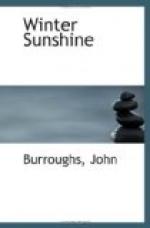In the morning, I mounted the wall in front of the cathedral, and, with a very lively feeling of wonder and astonishment, walked completely around the town on top of it, a distance of about two miles. The wall, being in places as high as the houses, afforded some interesting views into attics, chambers, and back yards. I envied the citizens such a delightful promenade ground, full of variety and interest. Just the right distance, too, for a brisk turn to get up an appetite, or for a leisurely stroll to tone down a dinner; while as a place for chance meetings of happy lovers, or to get away from one’s companions if the flame must burn in secret and in silence, it is unsurpassed. I occasionally met or passed other pedestrians, but noticed that it required a brisk pace to lessen the distance between myself and an attractive girlish figure a few hundred feet in advance of me. The railroad cuts across one corner of the town, piercing the walls with two very carefully constructed archways. Indeed, the people are very choice of the wall, and one sees posted notices of the city authorities offering a reward for any one detected in injuring it. It has stood now some seven or eight centuries, and from appearances is good for one or two more. There are several towers on the wall, from one of which some English king, over two hundred years ago, witnessed the defeat of his army on Rowton Moor. But when I was there, though the sun was shining, the atmosphere was so loaded with smoke that I could not catch even a glimpse of the moor where the battle took place. There is a gateway through the wall on each of the four sides, and this slender and beautiful but blackened and worn span, as if to afford a transit from the chamber windows on one side of the street to those of the other, is the first glimpse the traveler gets of the wall. The gates beneath the arches have entirely disappeared. The ancient and carved oak fronts of the buildings on the main street, and the inclosed sidewalk that ran through the second stories of the shops and stores, were not less strange and novel to me. The sidewalk was like a gentle upheaval in its swervings and undulations, or like a walk through the woods, the oaken posts and braces on the outside answering for the trees, and the prospect ahead for the vista.
The ride along the coast of Wales was crowded with novelty and interest,—the sea on one side and the mountains on the other,—the latter bleak and heathery in the foreground, but cloud-capped and snow-white in the distance. The afternoon was dark and lowering, and just before entering Conway we had a very striking view. A turn in the road suddenly brought us to where we looked through a black framework of heathery hills, and beheld Snowdon and his chiefs apparently with the full rigors of winter upon them. It was so satisfying that I lost at once my desire to tramp up them. I barely had time to turn from the mountains to get a view of Conway Castle, one of the largest and most impressive ruins I saw. The train cuts close to the great round tower, and plunges through the wall of gray, shelving stone into the bluff beyond, giving the traveler only time to glance and marvel.




